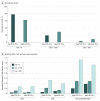Association of Coronary Artery Calcium With Long-term, Cause-Specific Mortality Among Young Adults
- PMID: 31322693
- PMCID: PMC6646982
- DOI: 10.1001/jamanetworkopen.2019.7440
Association of Coronary Artery Calcium With Long-term, Cause-Specific Mortality Among Young Adults
Abstract
Importance: The level of coronary artery calcium (CAC) can effectively stratify cardiovascular risk in middle-aged and older adults, but its utility for young adults is unclear.
Objectives: To determine the prevalence of CAC in adults aged 30 to 49 years and the subsequent association of CAC with coronary heart disease (CHD), cardiovascular disease (CVD), and all-cause mortality.
Design, setting, and participants: A multicenter retrospective cohort study was conducted among 22 346 individuals from the CAC Consortium who underwent CAC testing (baseline examination, 1991-2010, with follow-up through June 30, 2014; CAC quantified using nonconrast, cardiac-gated computed tomography scans) for clinical indications and were followed up for cause-specific mortality. Participants were free of clinical CVD at baseline. Statistical analysis was performed from June 1, 2017, to May 31, 2018.
Main outcomes and measures: The prevalence of CAC and the subsequent rates of CHD, CVD, and all-cause mortality. Competing risks regression modeling was used to calculate multivariable-adjusted subdistribution hazard ratios for CHD and CVD mortality.
Results: The sample of 22 346 participants (25.0% women and 75.0% men; mean [SD] age, 43.5 [4.5] years) had a high prevalence of hyperlipidemia (49.6%) and family history of CHD (49.3%) but a low prevalence of current smoking (11.0%) and diabetes (3.9%). The prevalence of any CAC was 34.4%, with 7.2% having a CAC score of more than 100. During follow-up (mean [SD], 12.7 [4.0] years), there were 40 deaths related to CHD, 84 deaths related to CVD, and 298 total deaths. A total of 27 deaths related to CHD (67.5%) occurred among individuals with CAC at baseline. The CHD mortality rate per 1000 person-years was 10-fold higher among those with a CAC score of more than 100 (0.69; 95% CI, 0.41-1.16) compared with those with a CAC score of 0 (0.07; 95% CI, 0.04-0.12). After multivariable adjustment, those with a CAC score of more than 100 had a significantly increased risk of CHD (subdistribution hazard ratio, 5.6; 95% CI, 2.5-12.7), CVD (subdistribution hazard ratio, 3.3; 95% CI, 1.8-6.2), and all-cause mortality (hazard ratio, 2.6; 95% CI, 1.9-3.6) compared with those with a CAC score of 0.
Conclusions and relevance: In a large sample of young adults undergoing CAC testing for clinical indications, 34.4% had CAC, and those with elevated CAC scores had significantly higher rates of CHD and CVD mortality. Coronary artery calcium may have potential utility for clinical decision-making among select young adults at elevated risk of cardiovascular disease.
Conflict of interest statement
Figures

References
-
- Stone NJ, Robinson JG, Lichtenstein AH, et al. ; American College of Cardiology/American Heart Association Task Force on Practice Guidelines . 2013 ACC/AHA guideline on the treatment of blood cholesterol to reduce atherosclerotic cardiovascular risk in adults: a report of the American College of Cardiology/American Heart Association Task Force on Practice Guidelines. J Am Coll Cardiol. 2014;63(25, pt B):-. doi:10.1016/j.jacc.2013.11.002 - DOI - PubMed
-
- Whelton PK, Carey RM, Aronow WS, et al. . 2017 ACC/AHA/AAPA/ABC/ACPM/AGS/APhA/ASH/ASPC/NMA/PCNA guideline for the prevention, detection, evaluation, and management of high blood pressure in adults: executive summary: a report of the American College of Cardiology/American Heart Association Task Force on Clinical Practice Guidelines. Hypertension. 2018;71(6):1269-1324. doi:10.1161/HYP.0000000000000066 - DOI - PubMed

